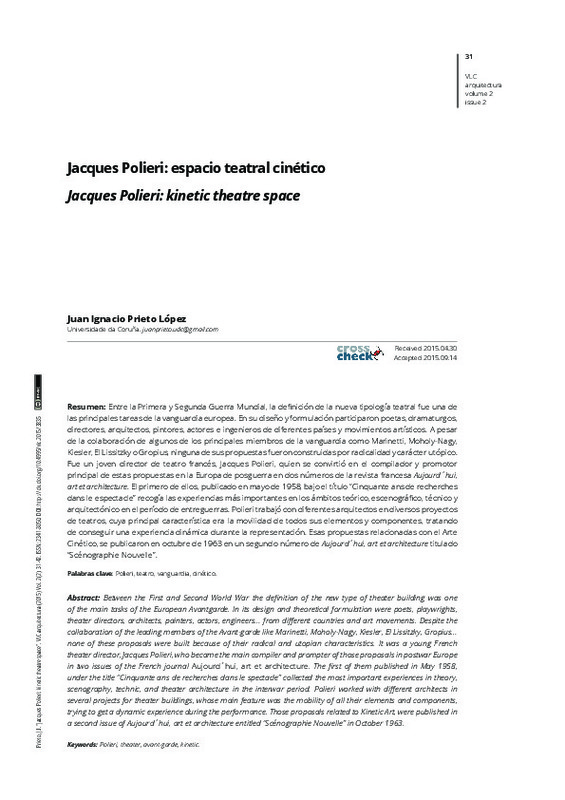|
Resumen:
|
[EN] Between the First and Second World War the definition of the new type of theater building was one of the main tasks of the European Avantgarde. In its design and theoretical formulation were poets, playwrights, theater ...[+]
[EN] Between the First and Second World War the definition of the new type of theater building was one of the main tasks of the European Avantgarde. In its design and theoretical formulation were poets, playwrights, theater directors, architects, painters, actors, engineers… from different countries and art movements. Despite the collaboration of the leading members of the Avant-garde like Marinetti, Moholy-Nagy, Kiesler, El Lissitzky, Gropius… none of these proposals were built because of their radical and utopian characteristics. It was a young French theater director, Jacques Polieri, who became the main compiler and prompter of those proposals in postwar Europe in two issues of the French journal Aujourd´hui, art et architecture. The first of them published in May 1958, under the title “Cinquante ans de recherches dans le spectacle” collected the most important experiences in theory, scenography, technic, and theater architecture in the interwar period. Polieri worked with different architects in several projects for theater buildings, whose main feature was the mobility of all their elements and components, trying to get a dynamic experience during the performance. Those proposals related to Kinetic Art, were published in a second issue of Aujourd´hui, art et architecture entitled “Scénographie Nouvelle” in October 1963
[-]
[ES] : Entre la Primera y Segunda Guerra Mundial, la definición de la nueva tipología teatral fue una de
las principales tareas de la vanguardia europea. En su diseño y formulación participaron poetas, dramaturgos,
directores, ...[+]
[ES] : Entre la Primera y Segunda Guerra Mundial, la definición de la nueva tipología teatral fue una de
las principales tareas de la vanguardia europea. En su diseño y formulación participaron poetas, dramaturgos,
directores, arquitectos, pintores, actores e ingenieros de diferentes países y movimientos artísticos. A pesar
de la colaboración de algunos de los principales miembros de la vanguardia como Marinetti, Moholy-Nagy,
Kiesler, El Lissitzky o Gropius, ninguna de sus propuestas fueron construidas por radicalidad y carácter utópico.
Fue un joven director de teatro francés, Jacques Polieri, quien se convirtió en el compilador y promotor
principal de estas propuestas en la Europa de posguerra en dos números de la revista francesa Aujourd´hui,
art et architecture. El primero de ellos, publicado en mayo de 1958, bajo el título “Cinquante ans de recherches
dans le espectacle” recogía las experiencias más importantes en los ámbitos teórico, escenográfico, técnico y
arquitectónico en el período de entreguerras. Polieri trabajó con diferentes arquitectos en diversos proyectos
de teatros, cuya principal característica era la movilidad de todos sus elementos y componentes, tratando
de conseguir una experiencia dinámica durante la representación. Esas propuestas relacionadas con el Arte
Cinético, se publicaron en octubre de 1963 en un segundo número de Aujourd´hui, art et architecture titulado
“Scénographie Nouvelle”
[-]
|








